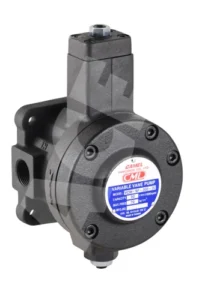Contact : +91-79045 61980 | Email: hydrofitengineers@gmail.com
Hydraulic Vane Pumps
Reliable and Efficient Solutions for Your Hydraulic Systems
Hydraulic Vane Pumps are key components in an assortment of industrial and mobile applications. These pumps are efficient, high flow, compact and can be adjusted for multiple applications that demand more than one preset pressure and flow. At Hydrofit Engineers, we offer the best hydraulic vane pumps to match your specific requirements and operations.
When someone in Chennai looking for a variable displacement vane pump, fixed displacement pump, or specific brands like the Yuken vane pump, we offer reliable solutions that enhance the performance of their hydraulic systems.
What Are Hydraulic Vane Pumps?
A hydraulic vane pump is a type of positive displacement pump in which a set of sliding vanes mounted in a rotor sweep fluid through expanding and contracting chambers as the rotor turns. The vanes maintain contact with the cam ring or housing, thus creating suction and discharge.
Key highlights of hydraulic vane pumps:
- They deliver relatively smooth, pulseless flow compared to gear pumps.
- They can accommodate a range of fluid viscosities and pressures.
- They are compact, relatively quiet, and can be designed for either fixed or variable displacement.
How Many Type of Hydraulic Vane Pump?
Below is a structured breakdown of the common vane pump types (also known as vane hydraulic pump variants):
- By using a balanced vane pump design, net radial thrust can be fairly well neutralized with either such symmetrical configurations or by twin pumps opposing each other.
- It means reduced bearing load, noise and longer life.
- Balanced vane configurations are ideal for medium to high pressures.
- In a fixed vane pump, the displacement is constant.
- The rotor is offset-mounted, and vanes slide in and out to keep gas-tight chambers.
- Side loads on the bearings are induced due to the internal unbalanced pressure particularly at higher pressure.
- Advantages: simplicity, decrease in cost, control components reduction.
- Downsides: Not as efficient in variable loads, bearing wear may present an issue, not as flexible.
- Change the output flow by adjusting a variable displacement vane pump.
- The cam ring angle, eccentricity can be varied to control it.
- Still other designs provide pressure compensating (self-adjusting) or load sensing, which allows for variable flow in accordance with demand.
- These pumps save energy, eliminate over-scaling and improve overall operation of multi-function systems.
- The trade-off is greater complexity and expense. know more about this type of pumps here.
Category | Description | Use Case / Strengths |
Fixed Displacement / Unbalanced Vane Pump | Delivers a constant flow per rotation, internal pressure forces are not fully balanced | Simple, reliable, cost-effective; good for constant-load systems |
Balanced Vane Pump | Designed so pressure forces are internally balanced, reducing radial loads | Less wear on bearings; better for higher pressures |
Variable Displacement Vane Pump | Displacement (flow) can be varied by changing geometry or cam angle | Efficient for systems with varying demand; energy saving |
Pressure-Compensated / Load-Sensing Vane Pump | Automatically modulates displacement based on system pressure or load | Smart, energy-efficient control for dynamic systems |



Applications of All Types of Vane Pumps
Hydraulic vane pumps (fixed, balanced, unbalanced, variable) find various use across industries. Some common uses are:
- Industrial machinery – machining centers, presses, hydraulic test benches, etc.
- Mobile hydraulics – construction equipment, lifts and mobile cranes.
- Injection molding& plastic machinery & where variable flows are required.
- Material handling systems – lifts and conveyors.
- Power steering & automotive hydraulic applications. Packaging / printing machinery
- Generally used in aircraft hydraulics; as a power source for simulators to apply load weights for this training equipment or aerospace (where an infinitely variable demand is present).
Why Choose Vane Pump?
Why choose a vane pump over gear or piston alternatives? Here are key advantages and consideration both:
Advantages | Considerations |
Quiet operating – pulsation below 70db | Vanes wear on sliding contact so fluid cleanliness and correct lubrication are extremely important |
Lightweight and compact design – fits in tight installation spaces | High-pressure applications may exceed in piston designs |
Reasonably good volumetric efficiency over a wide range (when properly designed | Variable displacement arrangements can introduce cost and complexity |
Less noise and vibration than some piston pumps with Lower maintenance | Performance may differ according to fluid viscosity and temperature |
Versatility -variable displacement / compensated configurations follow system requirements |
Get Hydraulic vane pumps at best prices?
FAQs
What is a hydraulic vane pump and how does it work?
When the rotor rotates, the vanes slide in and out of contact with the bore-wall as they on their edges seal off blood flow into expanding chambers for suction service (filled or atmospheric pressure) and contractile service (discharge).
How many types of vane pumps you deal with?
There are various types including unbalanced pump (fixed displacement), balanced pump, variable displacement pump, pressure compensated type and load sensing type pump. Each category has a specific need for pressure, flow and control.
What about vane pump use all kinds of vane pump?
These pumps have a wide number of applications in both industrial and mobile equipment from air conditioning to automotive transmission systems, as well as pharmaceutical processing, control systems and food manufacturing. Find more hydraulic gear pumps as well.
Why should vane pump be used instead of other types of hydraulic pumps?
Smooth and silent flow, compactness, ease of maintenance (In comparative models), adaptation to multiple types, efficiency is relatively good across the ranges and low vibration. Disadvantages are vane wear, sensitivity to quality and temperature of fluid, and limitation in very high pressures.
